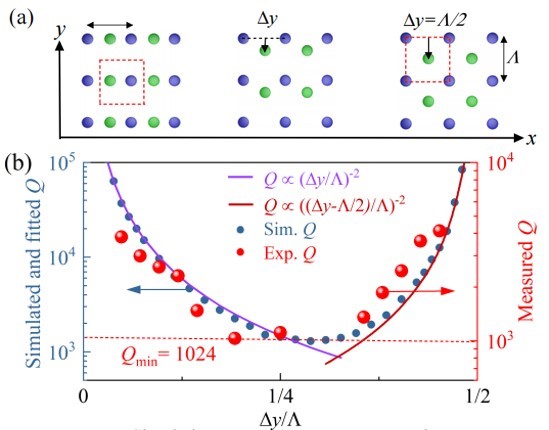Quasi-bound States in the Continuum Can Have High Quality Factors that Are Robust to Disturbances
Date:18-09-2023 | 【Print】 【close】
High-quality (Q-factor) metasurfaces have emerged as an exciting platform for enhancing light–matter interactions at the nanoscale and enabling a diverse range of applications, such as nanolaser, white-light LED, photoluminescence enhancement, nonlinear optics, and sensitive biochemical sensor. Recently, bound states in the continuum (BICs) have infinite Q factors due to the vanishing leakage to the free space, intriguing extensive interests in metasurfaces.
A research group led by Prof. Guangyuan LI from Shenzhen Institute of Advanced Technology (SIAT) of Chinese Academy of Sciences proposed a novel strategy to achieve robust ultrahigh-Q quasi-BICs (bound states in the continuum) in all-dielectric metasurfaces based on lattice hybridization.
The study was published in Advanced Optical Materials on Sep. 07.
Since BICs do not couple with free space light, one usually introduces asymmetric disturbances so as to transfer BICs into high-Q quasi-BICs. Conventionally, the asymmetry parameter should be less than 10% in order to obtain high Q factors. This imposes stringent requirements on the nano-fabrication processes, because multiple pattern transfers during evaporation, lithography, and etch would bring inevitable deviations on the size and shape and thus significant decrease on the measured Q factors.
In this study, researchers proposed a new approach to tackle this challenge. They made use of the hybridization of two lattices of periodic silicon nanorods with relative displacement being the asymmetry disturbance, which is robust to the pattern transfers during the nanofabrication. They further observed an interesting transition between two BICs, the electric quadrupole and the toroidal dipole BICs, which correspond to two in-plane mirror-symmetry points, during the asymmetry parameter varies over the whole possible range. This significantly improves the minimum achievable Q factor of the quasi-BIC, suggesting robustness to the asymmetry parameter.
Thanks to the robustness to both the design and the nanofabrication, they managed to demonstrate robust high-Q quasi-BICs with the minimum Q factor of 1317 in theory and 1024 in experiment, and the maximum Q factor of 4130 in experiment.
"In the literature, the focus of BIC-based metasurfaces has been on the maximum achievable Q factors. However, both the simulated and experimental Q factors decay quickly as the designed and the fabricated asymmetry parameter deviates from the target," said Dr. LI, "this requires very careful design and nanofabrication, and motivated us to pay special attention to the minimum Q factor as the asymmetry parameter varies."

Taking advantage of the hybridization of two lattices with displacement, both the simulated and measured Q factors show considerably high Q factors as the asymmetry parameter varies. (Image by SIAT)
Media Contact:
ZHANG Xiaomin
Email:xm.zhang@siat.ac.cn